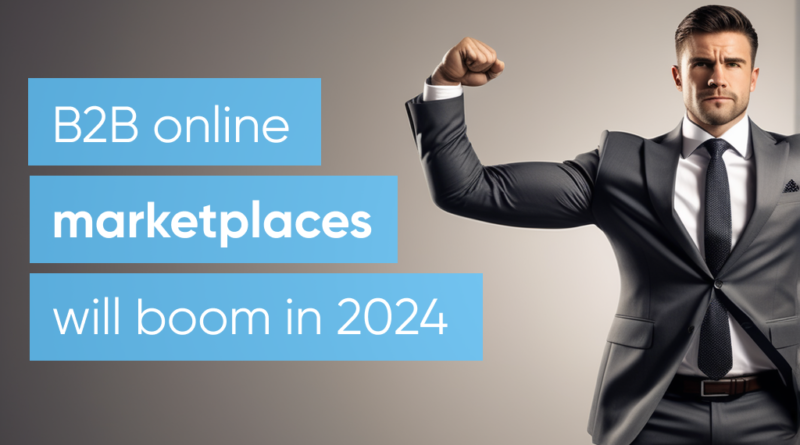The Rise of B2B Marketplaces: Major Shifts Set to Shape 2024 in B2B eCommerce
The B2B eCommerce marketplaces have experienced significant growth in the recent two years, and new marketplaces are emerging at a rapid pace.
The number of U.S. B2B marketplaces will exceed 750 within two years, Digital Commerce 360 projects. B2B marketplaces are also expected to grow 100% in 2023, with sales totaling $260 billion, up from $130 billion.
More businesses are buying and selling online, and this change is particularly noticeable in B2B transactions. B2B buyers are now more comfortable making big deals on the internet, leading to the success of online marketplaces.
This shift is like a big wave of change in B2B eCommerce. Wholesalers, businesses that sell large quantities of goods, are growing faster than manufacturers in recent times. Marketplaces offer practical advantages, like easy price comparisons and more customers for buyers. All of these trends show how much B2B marketplaces are growing and making a big impact in the digital economy.
What Shifts Happening in B2B eCommerce?
Big changes are happening in the world of online business-to-business (B2B) marketplaces. Here are some important things to know:
- More online buying: Businesses are getting more comfortable making big deals online through marketplaces.
- Fast growth: B2B marketplaces are getting bigger really quickly and are becoming a popular way for businesses to sell to each other. Sales are expected to double in 2023!
- Digitalization: B2B marketplaces are helping businesses go digital by letting them buy and sell online. This means businesses can see how much stock is available in real-time, saving them time and effort. The company that runs the marketplace also gets useful information about business customers.
- Flexibility and quick response: Marketplaces allow businesses to pivot, experiment, and respond swiftly to market shifts, providing flexibility that traditional trade practices may not offer.
- The rise of government marketplaces: B2B marketplaces created and supported by the U.S. government began to pop up. The goal of these initiatives is to provide a secure, modern buying and spend-management experience for government agencies. This demonstrates the increasing involvement of government entities in B2B marketplaces to streamline procurement processes and enhance transparency.
- AI adoption: Companies are using AI to give personalized product suggestions, set the right prices, manage inventory, predict what customers will want, and do tasks in the background automatically. More and more businesses are starting to use AI in online business-to-business (B2B) shopping. In the last four years, the number of businesses using AI has gone up by a lot—270% more businesses are now using it!
These changes show how important B2B marketplaces are becoming in the digital world, reshaping how businesses buy and sell from each other. Let’s take a closer look at these shifts.
More Online Buying
Businesses are becoming more comfortable making big deals online through B2B marketplaces. The growth of B2B marketplaces has been significant, with platforms like Faire, Amazon Business, Tundra, Alibaba, and others experiencing rapid expansion.
These marketplaces serve as valuable sales channels for B2B organizations, allowing businesses to reach B2B buyers, deliver products faster, and expand into new markets.
The advantages of using B2B e-commerce platforms include improved efficiency, cost savings, wider product choices, and global accessibility, which have contributed to the increasing comfort of businesses in making big deals online.
The shift towards online purchasing from wholesalers and manufacturers is driven by factors such as trust in the marketplace, existing purchasing processes, and the ability to reach a wider customer base.
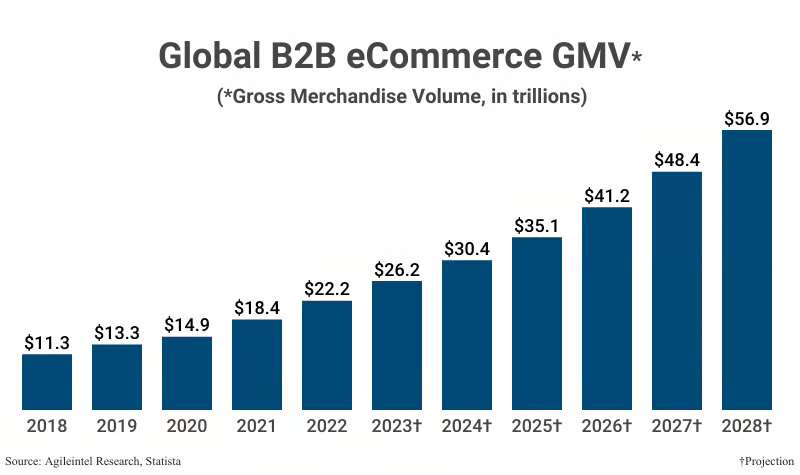
Fast Growth
In 2023, B2B marketplaces are booming, with sales set to hit $260 billion—double the $130 billion in the previous year. These marketplaces are becoming mainstream in B2B ecommerce, expected to represent 12% of total B2B sales, up from 7% in 2022.
Over 500 B2B marketplaces are already operational, and projections suggest there could be over 1,000 in the next five years. This growth is fueled by various models and platforms, including commercial giants like Amazon Business.
B2B e-commerce platforms offer advantages like efficiency, cost savings, diverse product options, and global access. Selling through B2B marketplaces provides benefits such as leveraging the marketplace’s reputation and expanding into new markets. As B2B marketplaces thrive, they become increasingly crucial for businesses to connect, source products, and expand globally, reshaping modern commerce.
In 2022-2023, we’ve seen an increase in the number of B2B marketplaces created by our customers using CS-Cart. There are over 150 B2B marketplaces of various sizes running on CS-Cart worldwide, which has almost doubled since 2020.
Ely Makarov, CEO of CS-Cart.
Digitalization
B2B marketplaces are changing how businesses buy things online. While B2C (business-to-consumer) has lots of online marketplaces, B2B is also growing fast. The sales from B2B marketplaces are expected to double to $112 billion in 2023 from $56 billion in 2022.
These marketplaces are important because they make buying things for businesses easier. For example, Accor Group created a platform called Astore Shop to help its hotels buy things online from different suppliers in one place.
Using these marketplaces helps suppliers reach more customers, lets buyers shop online easily, and gives the platform owners access to useful data. Even though people think B2B is slower with technology, it has actually been using systems like ERPs and EDI for a long time.
B2B didn’t wait for eCommerce to digitize itself.
Marc Teulières, the B2B General Manager at the marketplace platform Mirakl
Flexibility and Quick Response
B2B marketplaces are becoming more popular because they offer flexibility and quick responses. These marketplaces allow businesses to adapt, try new things, and react fast to changes in the market. This flexibility is something traditional ways of doing business might not provide.
B2B marketplaces also give businesses choices by offering various products and services from different suppliers. This lets businesses pick what suits their needs best. They can even negotiate prices and terms with suppliers, making transactions more customizable and flexible.
Moreover, having flexible payment options and financing is crucial for businesses, especially when making large purchases. This flexibility in payments helps transactions happen faster and more securely.
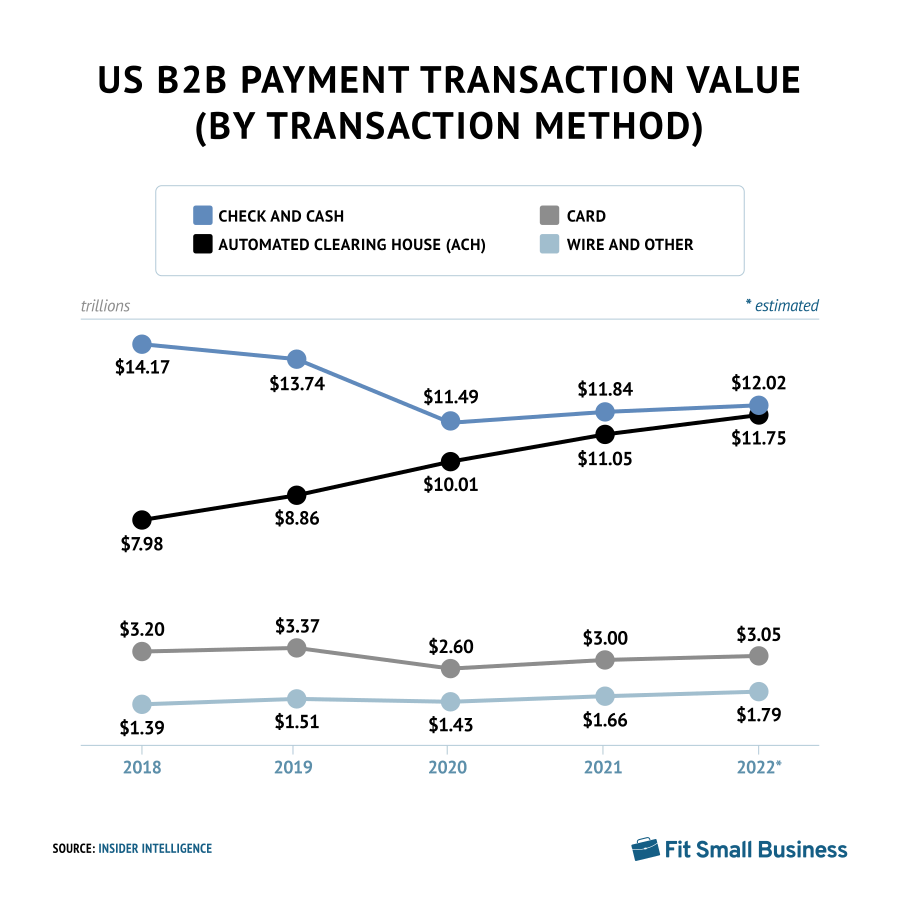
It also helps businesses manage their money better, filling in gaps and supporting growth. In summary, B2B marketplaces are changing how businesses buy and sell things, making the whole process quicker, more transparent, and cost-effective.
The Rise of Government Marketplaces
The U.S. federal government’s B2B marketplace, initiated in July 2020 by the General Services Administration (GSA), is gradually gaining traction. An MVP, started in 2018, aimed to assess the feasibility of creating a federal B2B marketplace for government purchases under $10,000.
As of fiscal year 2022, sales through the program reached $53 million, a substantial increase from $12.5 million in 2019. The number of third-party suppliers nearly doubled, and the program’s operating cost for fiscal year 2022 was approximately $1.5 million. Amazon Business is the primary beneficiary, with 27 agencies currently using the marketplace.
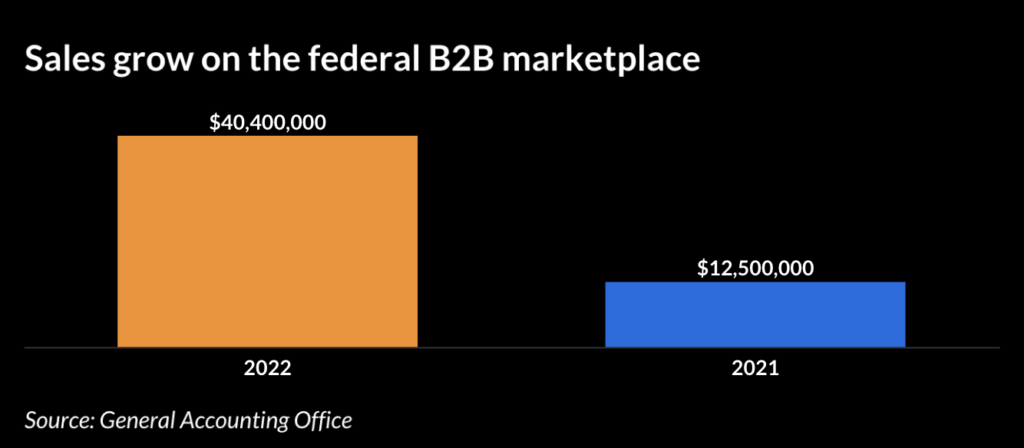
This federal B2B marketplace aligns with the broader trend of B2B marketplaces becoming a mainstream business-to-business sales channel. Sales in this sector are expected to grow by 100% in 2023, reaching a total of $260 billion, up from $130 billion. Additionally, the number of U.S. B2B marketplaces is projected to exceed 750 within two years.
AI Adoption
AI is changing B2B eCommerce by automating tasks and making operations more efficient. The number of businesses using AI has grown by 270% in the past four years.
AI optimizes pricing and inventory management, leading to better decisions and increased profitability. Recent data shows that AI can improve inventory accuracy by up to 95%. It helps businesses make informed decisions, save time, and increase efficiency.
In logistics, AI enhances efficiency and reduces costs. It accurately forecasts product demand and identifies cost-effective delivery routes, improving customer satisfaction. Use cases of AI on B2B marketplaces include:
- Supply chain management
- Demand forecasting
- Personalized business experiences
- Product development
- Marketing strategies
- Improved client service,
- and more.
AI in B2B eCommerce is transforming operations, and businesses are adopting it for better decision-making, increased efficiency, and higher profitability.
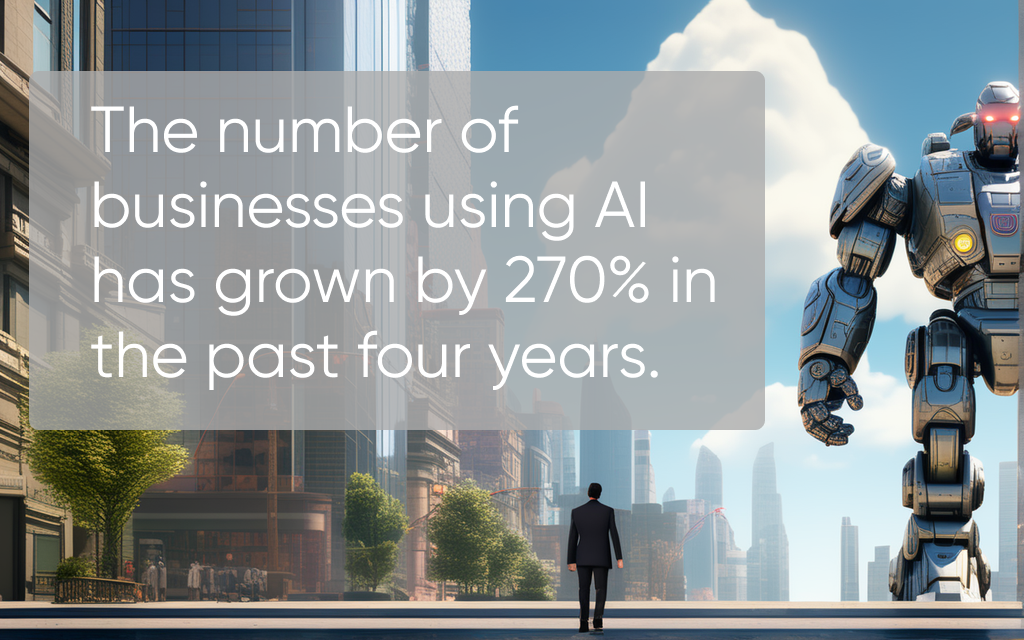
What to Expect from B2B Marketplaces in 2024?
In 2024, B2B eCommerce is set to see some important changes:
- Generative AI Growth: The use of generative AI is expected to increase, but concerns about accuracy and security may persist. This technology will play a role in influencing new B2B product launches.
- Amazon Business Influence: Amazon Business is likely to impact the midmarket more, using its strengths in pricing and logistics. This could be challenging for midmarket firms that compete mainly on product availability and price.
- Marketplace Expansion: The growth of B2B marketplaces will continue, and there could be over 1,000 within the next two years. This shows that more businesses are adopting B2B marketplaces as a way to sell their products.
- Challenges and Opportunities: B2B companies will face highs and lows in 2024, dealing with partner-centered growth, demand, technology, and legal challenges. Partner ecosystems will become more crucial, presenting challenges and opportunities for marketing, sales, and product teams.
- Digital Sales Focus: The focus on digital sales and adopting new technologies like voice search and automated order management systems will remain a priority. Trends like headless commerce and the growth of B2B online marketplaces will continue to shape the B2B eCommerce landscape.
These changes point to a dynamic and transformative year ahead for B2B eCommerce, with advanced technologies integrating further, market dynamics evolving, and B2B companies needing to adapt quickly.
If you’re currently looking for a way to start a B2B eCommerce marketplace, check out our B2B Marketplace Mastering Guide. Also, check out CS-Cart, a marketplace platform for developing a marketplace for any business scenario.
Yan Anderson is the Head of Content Marketing at CS-Cart with over 10 years of experience in the eCommerce industry. He's passionate about explaining complicated things in simple terms. Yan has expertise in building, running and growing eCommerce marketplaces. He loves to educate people about best practices, new technologies, and trends in the global eCommerce industry.
